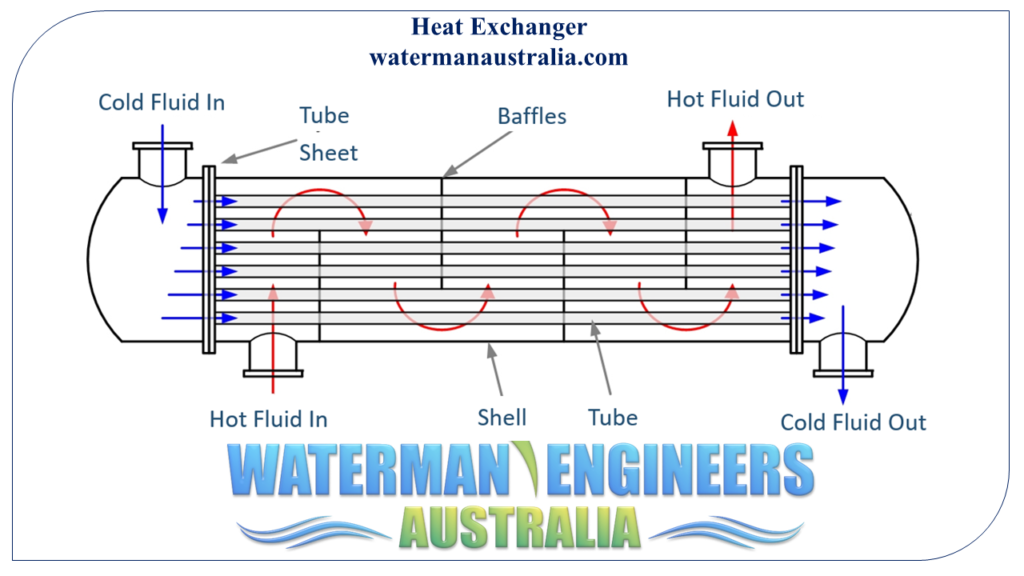
A heat exchanger is a device that allows for the transmission of heat between two different media without any physical contact between them. Heat exchangers work on the idea that thermal energy can be transferred from a hot fluid to a cold fluid. Heat exchangers provide for precise temperature regulation, improving energy efficiency and system functionality by transferring heat between two fluids.
Power plants, chemical plants, HVAC (heating, ventilation, and air conditioning) systems, supermarkets, and many more all employ heat exchangers. They can be found in commonplace home products like air conditioners and water heaters.
In this article, we'll learn about heat exchangers, what they are, how they work, and the different kinds there are. The article also details the common uses and factors to consider when choosing a heat exchanger.
For soiled and viscous fluids, the fouled tension drop in a heat exchanger could be nearly thrice the clear tension fall, equally inside of and outside tubes. Trying to keep velocities higher more than enough to avoid deposits, keeping away from stagnant location/scorching spot/cold spot are mitigation steps in heat exchanger thermal design and style. Inside the HTRI application, fouling layer thickness is usually entered specifically.
The main fluid is drinking water however the secondary fluid is air blown throughout the fins on the heat exchanger with fans. Normally, there aren't any transferring sections during the heat exchanger only exterior supporters to flow into the air.
Whether sq. or rotated square pitch should be employed depends upon the diploma of turbulence over the shell facet. Where That is minimal, as is the case with viscous liquids, a rotated sq. pitch yields a much greater heat transfer coefficient for a similar tension fall. The kind of cleansing system (chemical/mechanical) adopted via the shopper also drives the pitch selection.
H2o-cooled condensers use h2o to chill the refrigerant and release heat. They’re far more economical than air-cooled variations, but can have to have much more routine maintenance and may not be ideal for spots with drinking water limitations.
To assess the cooling effectiveness of the EAHX, two principal Designing of heat exchanger manufacturer indices are used (monitoring information verify negligible latent heat exchanges within the EAHX in the course of the dry summer months interval; further more aspects offered in Segment 3.one):
This type of heat exchanger is usually quite compact although not to a similar extent as PHE. They might cope with layout pressures as many as 25 bar g and design temperatures nearly 400°C, as they've got traditional gaskets. Therefore, the applicability of SHE is way wider than that of PHE.
Even so when cost change is not really important, prefer seamless tubes for a protracted existence cycle of exchanger bundle.
Fouling will be the deposition of unwanted subject about the heat exchange floor, which decreases the heat Trade. This is certainly an especially crucial parameter of the exchanger design and style. A better fouling resistance translates right into a minimized heat transfer.
Considering the fact that these elements are certainly not indicated, engineers frequently are convinced tubes do not need any corrosion allowance. Even so, if a fluid is excess-corrosive, the next tube wall thickness must be picked. It's the responsibility in the purchaser’s materials professional to specify the tube thickness.
The overall heat transfer coefficient is predicated on the surface surface area spot from the wall for your finned tubular heat exchangers,
In the event only one of many fluids is fouling, BEM-sort with mounted tubesheets welded for the shell and straight tubes is among the most economical. The fouling fluid shall be around the tube facet, that may be mechanically cleaned, since the tubes are straight.
Though the devices design and style specification geared up by the operator/consumer seeks to serve the operate of familiarizing the designer with the general plant requires, the breadth and depth of data located in the “specs” may differ substantially. The material delivered With this chapter is aimed to supply the designer with an summary of these “trans-style” subject areas. Engineers engaged in specification improvement, and plant staff answerable for heat exchanger inspection and upkeep, will likely locate the data presented listed here handy within their do the job.
Heat exchangers working experience much more tension drop as they get fouled as a result of a discount in the region on the move passages. Although fouling resistance is taken into account by Virtually all designers to account for your reduction in heat transfer, only a few of them look at fouling layer thickness to account for the upper tension fall. This is very anomalous because the deposit will come initial after which you can, as being a consequence, the thermal resistance.
Cross-flow heat exchangers also use flat plates, but the air flows at correct angles. The units Possess a smaller sized footprint and may even fit in a window, but lose a few of the counter-movement efficiency.